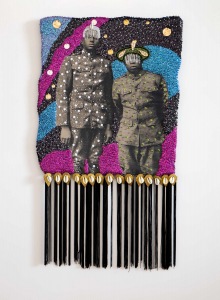
BY TAYLOR BLYTHEWOOD–PORTER
September 14-October 19, 2024
Following the passing of his father, artist Demetri Broxton sought to reconnect with his Creole and Filipino heritage through meditation and reflection, revisiting twentieth century family photographs that were given to him by his grandmother. 1 The photographs found their way into a series of five large-scale textile works included in Broxton’s recent exhibition Ancestral Echoes at Patricia Sweetow Gallery. Alongside the archival photographs, which had been passed down through generations, the textiles are adorned with materials like sequins, antique silk, glass beads, and cowrie shells. Investigating personal genealogy and empowerment through material, Broxton weaves Afrofuturist narratives that tune into African cosmology while building new stories of agency and freedom.
Broxton integrated the photographs of his family members-sepia-toned images of men posing in uniform, couples posing together, and other portraits – as an act of ancestor worship. 2 Broxton prints the images on fabric before embellishing them with glass beads, crystals, chainette, brass elements, or 24-karat gold. His labor intensive practice venerates the photographs: The slow embellishment process acts as a sacred ritual performance that honors the ancestors. Keepers of the Altar (all works 2024) acknowledges the important role of ancestors in maintaining harmony and balance. A quartz and gold veil covers the faces of two figures, who stand beside a table with their hands placed upon a box. Cowrie shells are sewn over the box, and web-like lace covers the table. The inclusion of the shells harkens back to the transatlantic slave trade, in which cowrie shells were used as currency on the Western coast of Africa and were exchanged for enslaved people until the twentieth century. 3 Simultaneously, Broxton’s inclusion of the twentieth-century lace gestures to British imperialism, as the slave trade was a key factor in growing and enforcing European empires. These materials serve as a form of subversion and divination, underscoring that African spirituality is not a closed theological system. Broxton thus creates a portrait of his relatives as stewards of ancestral knowledge: They are, as anthropologist David Colon-Cabrera would say, the protagonists in this narrative-reimagining a future rooted in African traditions and knowledge and illustrating how the past is a continuing influence on the present.
4 In some African cosmologies, the human world lies between the sky and the earth. He Who Stands at the Crossroads is a rounded tapestry that includes an image of a soldier in a uniform that has been embellished with small keys and red beads. His face is veiled with clear quartz crystals, red beads line the brim of his hat, and he stands at a halt. Bravely appearing within this portal- like shape, the spirit serves as an intermediary between the human and ancestral plane, an ancestral soldier influencing the living through generational ripples. His figure is framed against a red, white, and blue beaded pattern. Gold-plated orbs are scattered throughout the background, a subtle nod to the American flag, while 24-karat gold-plated brass, cowrie shells, wooden beads, and black and red rayon bottom dangle from the bottom of the tapestry. Broxton reimagines a future where spirits occupy a higher level of existence between sky and Earth to bestow blessings from beyond and guide the living. Broxton’s textured tapestries decolonize the way we utilize anthropological knowledge.
Guardians: Private Foster Lillard and Private Felix Green (the only work whose title names Broxton’s relatives) emphasizes that ancestral lineage is cosmic. Taking the African diasporic world- view that challenges linear timelines, ancestry is more than a biological inheritance but a spiritual and meta physical interconnectedness with the universe that creates a loop of guidance and resilience. Through the lens of Afrofuturism and African cosmology, the ancestors are thought to provide guidance and protection.5 Guardians presents two veiled soldiers in uniform. One wears a light blue turban-style beaded headpiece with a single cowrie shell as a plum veiled in crystal, while the other is dressed in a green beaded brimmed hat with three stitched golden feathers. Evoking a galactic sky, the beaded background incorporates wave patterns and abstract lines in shades of blue, purple, and black. The act of creating a celestial ceremonial shrine is a way to both honor and access power. Invoking ancestral power in this way emphasizes Afrofuturism’s core tenets by reclaiming lost histories and spiritual connections to resist oppression and envision futures of liberation.
By centering traditional African materials and spiritualities alongside his family history, Broxton offers a holistic mode of engagement with ancestral knowledge. Through material and historical images, he employs coded iconography rooted in African diasporic tradition, transforming these symbols into a language that resists dominant episte- mologies and reframes cultural memory. In engaging with the past, we shift our under- standing of the present, expanding binary thinking to a cosmic wholeness that speaks across spiritual, social, economic, and artistic expressions. Broxton’s textiles operate as portals, where the threads of ancestral wisdom weave visions of futures defined by liberation. Through this lens, the past is not a static archive but an active guide, transforming how we navigate the present and shape what is to come.
1. Demetri Broxton (@dbroxtonstudio), “Shout out to my cousin,@ecincoli for capturing this emotional moment of my artist talk this past Saturday, October 5,” October 7, 2024, https:// www.instagram.com/reel/ DA2cxEvp8yo/.
2. Demetri Broxton (@dbroxtonstudio), “Shout out to my cousin:’
3. “Cowrie Shells and Trade Power,” National Museum of African American History & Culture, Smithsonian, accessed January 7, 2025.
4. David Colon-Cabrera, “Looking
for Humanity in Science Fiction through Afrofuturism;’ Society for Cultural Anthropology, December 18, 2018.
5. Afrofuturism: A History of Black Futures, eds. Kevin M. Strait and Kinshasha Holman Conwill (Washington, D.C.: The National Museum of African American History and Culture, 2023); lkechukwu Anthony Kanu, “The Dimensions of African Cosmology;’ Filosofia Theoretica: Journal of African Philosophy, Culture and Religion 2, no. 2 (2013).
